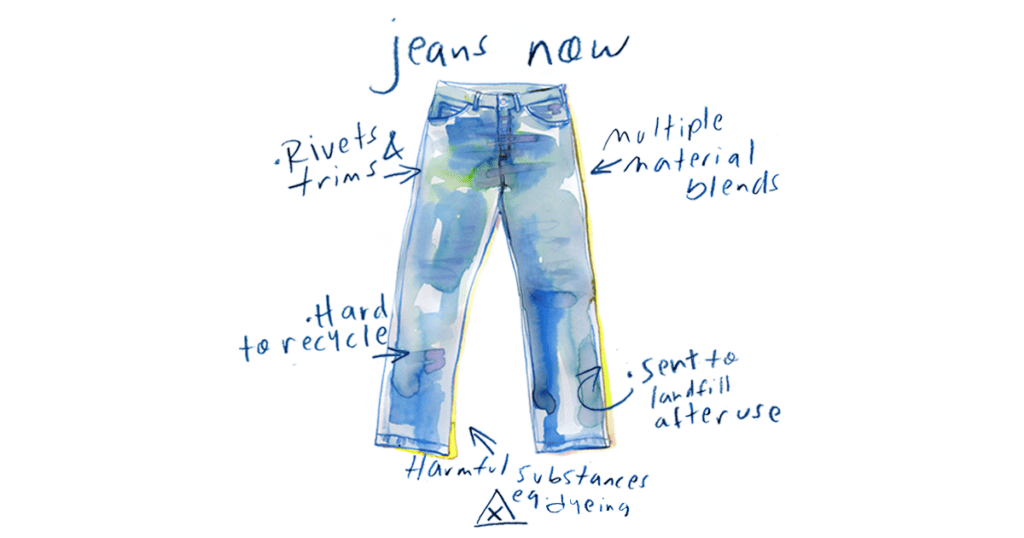ELLEN MACARTHUR FOUNDATION ON CIRCULAR SYSTEMS


Today fashion is primarily produced in a linear system, of “take, make, dispose”, with 73% of the world’s clothing eventually ending up in landfills.1 While some brands have initiated the process of redesigning their product lifecycles, complexities around changing the linear model have slowed down the movement towards circularity. Unless the whole industry acts now, the linear model risks pushing past planetary boundaries. As guided in Global Fashion Agenda’sFashion CEO Agenda – Circular Systems, the industry must first develop a fuller understanding around the impact of choices made during the product creation phase. This includes, but is not limited to, designing for durability, disassembly and recycling and increasing the share of recycled fibres in products.2
The Ellen MacArthur Foundation currently leads international efforts in this space and is committed to the creation of a circular economy that tackles some of the biggest challenges of our time, such as climate change and biodiversity loss. The Foundation’s Fashion Initiative brings together leaders from across the fashion industry to drive international efforts to stop waste and pollution through the creation of a circular economy. This system means designing products (apparel, footwear, accessories) that are used more, made to be made again and are produced from safe, recycled, or renewable inputs.
To demonstrate the possibilities of circular design for the fashion industry, in February 2019 Ellen MacArthur Foundation initiated The Jeans Redesign.
THE JEANS REDESIGN – DESIGNING FOR A CIRCULAR ECONOMY, TODAY.
Through the Ellen MacArthur Foundation’s Jeans Redesign project, participating brands have put more than half a million pairs of circular jeans on the market demonstrating momentous possibilities for the wider fashion industry when it comes to circular design.
For decades, the denim industry has been responsible for a significant amount of waste and pollution, as it requires a large amount of resources during production, such as pesticides, water, and energy. The iconic design and construction of jeans is also traditionally difficult to remake and recycle after use, all in all presenting a challenging but opportune starting point to address the flaws of the current linear economy.
The Jeans Redesign guidelines, created by the Foundation with input from over 80 denim experts, provides minimum requirements for durability, traceability, and recyclability, while using safe materials and processes to ensure jeans are fit for a circular economy.
To date, 94 participants representing of brands, retailers, garment manufacturers, and fabric mills are working towards The Jeans Redesign guidelines and common definitions with many going beyond the requirements to collaborate with other businesses, innovate for new technologies, and invest in knowledge, capacity, fixed assets, inventory, and procurement. The success of The Jeans Redesign has also ignited discussions around developing other products in line with circular design principles. For example, some participants are investigating solutions for garments including chinos, jackets, t-shirts and accessories being designed in the same way.
Whilst the number of redesigned jeans is just a small part of the total market, the insights gained can go a long way in informing bold action towards creating more products in this way providing a clear picture of the current landscape of solutions, barriers, and innovation gaps for the industry to act on now. The insights outlined also highlight the need for business alignment with policymakers on common criteria necessary to scale a circular economy for fashion.
THE JEANS REDESIGN – NEXT STEPS
In July 2021, The Jeans Redesign guidelines were updated to take into account what is needed to accelerate progress at speed and scale to create a circular economy for jeans, and account for changes in the innovation landscape of the fashion industry. As The Jeans Redesign continues, participants will take bold action to apply the guidelines across a greater proportion of their denim collections and organisations are encouraged to join current participants on this journey and work together towards the updated guidelines.
Find out more about The Jeans Redesign here.
CALL TO ACTION
Transitioning to a circular economy is a critical step on the pathway to reach science-based targets and reduce carbon by 45% by 2030. According to the Fashion On Climate Report, one in five garments must be traded through a circular business model by 2030 if we are to meet the Paris Agreement, demanding industry players to rapidly increase the pace of transformation to a circular fashion system.3 To understand how you can take action and be a part of this journey to achieving a circular economy visit the Fashion CEO Agenda – Circular Systems.
REFERENCES
1 Global Fashion Agenda. (2021) Fashion CEO Agenda 2021.
2 Global Fashion Agenda. (2021) Fashion CEO Agenda 2021.
3 Global Fashion Agenda. (2020) Fashion On Climate.